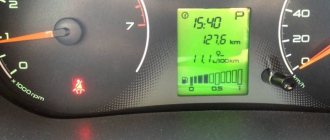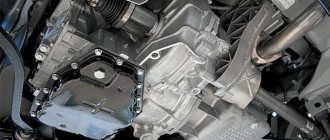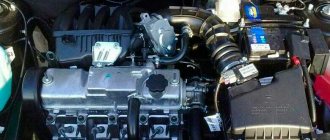Description
The VAZ-11183 engine was designed and put into production in 2004. Many design elements are taken from the VAZ-21114 engine. VAZ-11183 was produced until 2021. In 2011 it underwent a slight modernization, as a result of which it received an electronic drive for controlling the throttle valve (gas pedal).
The VAZ-11183 is a 1.6-liter gasoline inline four-cylinder engine with a power of 80 hp. s and torque 120 Nm.
Installed on Lada cars:
- 2112 (2004-2008);
- 2113 Samara (2004-2014);
- Grant (2011-2018);
- Kalina (2004-2013).
In addition to Lada, it can be seen under the hood of On-Do 1 (Datsun).
The opinion of auto experts about the engine is clear - the engine is simple in design and design compared to many other 8-valve AvtoVAZ engines.
The cylinder block is made of high-strength cast iron. The height is increased by 2.3 mm (compared to the VAZ-2110). Not sleeved.
The cylinder head is aluminum, with one camshaft and 8 valves (SOHC). To increase the compression ratio, the volume of the combustion chambers has been increased. There are no hydraulic compensators, so the thermal clearance of the valves has to be adjusted manually.
The crankshaft is steel, forged. It has a crank radius increased by 2.3 mm, which provides a piston stroke of 75.6 mm.
Timing belt drive. The main advantage is that the valves do not bend when they meet the pistons when the belt breaks. The engine simply stalls at this moment.
The attachments have their own drive belts.
Alternator belt drive
Power supply system – injector, distributed fuel injection. Practice has shown the possibility of using AI-92 gasoline. Justification - the compression ratio does not exceed 10 units (above 10 - only AI-95 or AI-98).
The advantage of the engine is the reserved safety margin, i.e. there is the possibility of tuning without reducing the mileage resource.
Engine 11186 (87 hp) - the valves bend!
Engine 11186 (under the hood)
11186 engine specially for CarFrance.ru from Grantovod Igor
When the timing belt breaks on engine 11186 of a Lada Granta, the valves bend; there have already been many cases that have confirmed this hypothesis. The most successful scenario for the development of events in the event of a timing belt break on this engine is the bending of the intake valves.
Engine 11186 (removed from the car)
Specifications
| Manufacturer | Concern "AvtoVAZ" | |
| Engine code | VAZ-11183 | VAZ-11183-50 |
| Start year of release | 2004 | 2011 |
| Volume, cm³ | 1596 | 1596 |
| Power, l. With | 80 | 82 |
| Torque, Nm | 120 | 132 |
| Compression ratio | 9.6 | 9.8 |
| Cylinder block | cast iron | cast iron |
| Number of cylinders | 4 | 4 |
| Fuel injection order | 1-3-4-2 | 1-3-4-2 |
| cylinder head | aluminum | aluminum |
| Cylinder diameter, mm | 82 | 82 |
| Piston stroke, mm | 75.6 | 75.6 |
| Number of valves per cylinder | 2 | 2 |
| Timing drive | belt | belt |
| Turbocharging | No | No |
| Hydraulic compensators | No | No |
| Valve timing regulator | No | No |
| Lubrication system capacity, l | 3.5 | 3.5 |
| Oil used | 5W-30 (40), 10W-40, 15W-40 | 5W-30 (40), 10W-40, 15W-40 |
| Fuel supply system | injector | injector |
| Fuel | gasoline AI-92 | gasoline AI-95 |
| Environmental standards | Euro 2-3 | Euro 4 |
| Resource, thousand km | 150 | 150 |
| Location | transverse | transverse |
| Weight, kg | 112 | 112 |
| Tuning (potential), l. With | 180* | 180* |
*tuning up to 120 hp is possible without loss of service life. With.
Gallery of engines with bent valves
Bent valve VAZ-2109
Bent Skoda valve (fist of friendship)
Skoda valve bent
Skoda valve bent
Toyota valve bent
The piston that pierced the block head
Engine VAZ-11183-50
This engine is a modification of the VAZ-11183. There are no fundamental design differences, but as a result of modifications:
- Power increased to 82 hp. With.
- Torque increased by 12 Nm.
- The environmental standard has increased to Euro
The main difference is that the unit is equipped with an electronic throttle control mechanism (type of action - “E-Gas”). The innovation improved engine controllability, but at the same time created a problem with the TPS sensor.
Engine builders managed to eliminate a number of shortcomings that were observed on its predecessor. For example, constant contamination of the throttle valve is a thing of the past.
Throttle Position Sensor (TPS)
As a result of modernization, the level of torque of the internal combustion engine and its elasticity have increased.
Car enthusiasts note that in general the engine has become more reliable and less capricious. At the same time, engine efficiency has decreased.
16 valve engine
Now let's talk about 16-valve engines for cars of the domestic manufacturer Lada Granta. These engines are already installed on luxury cars. The power of the power units has been increased, which has affected the reduction in fuel economy.
Some models are used on Lada Granta "Sport" class cars. They are distinguished by high-torque power and rapid development of speed from the start.
Similar article Engine for Gazelle Next: types, volume and characteristics
Technical specifications for Lada Granta
Let's look at the technical characteristics of the 16-valve engine model 21126. They are presented in the table.
| Parameter | Meaning |
| Type | Row |
| Cylinders | 4 |
| valves | 16 |
| Compression | 11 |
| Volume | 1.6 l |
| Cylinder diameter | 82 |
| Piston stroke | 75 |
| Power | 106 hp |
| Petrol | AI 95 |
| Weight | 115 kg |
| Life resource | 250 thousand km |
What distinguishes this engine from the previous two is the presence of DAT and DTV instead of DRMV. In this way, the manufacturer got rid of floating speed at idle speed of the engine. This improved the performance of the power unit from the Lada Grant. It’s true that these engines have become a little more expensive.
A broken timing belt still bends the valve. But this is the price to pay for making the engine lighter and increasing its power.
Now let's look at another engine that was installed on the “Lux” model from Lada Grant. Technical characteristics of this engine 21127.
| Parameter | Meaning |
| Type | L |
| Cylinders | 4 |
| Piston diameter and stroke | Same as previous ones |
| Compression | 11 |
| timing belt | DOHC |
| Torque | 148 Nm |
| Nutrition | Injection |
| Econorms | Euro 4 |
| Weight | 116 kg |
| Life resource | 250 thousand km |
There is another rare engine with 16 valves. It was installed only on “Sport” model cars. The modification of the power unit is designated VAZ 2126-77. It was an upgraded model 2126 engine.
The only difference from other engines was the increase in power after the tachometer crossed the three thousand rpm mark. And its power was 120 horses. Otherwise, it did not differ from the previous engines already described.
Engine design features
The sixteen-valve engine has a cast-iron cylinder block and an aluminum head. Another advantage of these engines was the ability to cover 100 meters in 11 seconds.
The maximum speed that the engine reached was considered to be 172 km/h. This is why car owners fell in love with these engines. Although there were some shortcomings. For example, bending of valves when a belt breaks. This was followed by a major overhaul or a complete change of the power unit.
These engines showed high power, which differed several times from that indicated in the data sheet. However, they often had problems that were also different from the passport problems.
For example, the car owner’s reluctance to take the engine for regular maintenance led to a decrease in the engine’s lifespan. The gasket and pistons on these engines burned out.
The water pump broke down with enviable frequency. Especially residents of the southern regions and those who like to kill cars in difficult operating conditions cannot boast of the absence of overheating.
Similar article What kind of oil to pour into an 8 valve Lada Granta
Motor life
The service life of sixteen-valve engines exceeds three hundred thousand kilometers if treated with care. The engine life is not lower than the eight-valve one, but does not exceed it, as can be seen from the tables above.
Despite such high engine durability, it has disadvantages that do not suit many car owners. Let's look at these disadvantages.
Reliability, weaknesses, maintainability
Reliability
According to the conclusion of servicemen and car owners, the VAZ-11183 is more reliable in comparison with the concern’s previously produced engines. The increased quality of components and mechanisms used in the engine is especially noticeable.
The manufacturer has determined the average mileage resource. In reality, it is more than twice as much as stated. This fact is clearly confirmed by the increased reliability of the unit.
In addition, the engine is unpretentious during operation. The lubrication system especially benefits in this regard. The oil quality requirements are somewhat underestimated due to the lack of hydraulic compensators. The stable operation of the engine on low-octane gasoline also pleases most car owners. In other words, the efficiency of the internal combustion engine has been increased without sacrificing reliability.
The reliability of the timing system is beyond praise. A broken drive belt does not cause the valves to bend, which saves the car owner from expensive repairs.
On various forums you can find the following reviews: “... the engine is class, the traction is what you need, at low speeds 3 uphill, and even with a load of 4 people. 80 kg each. I only fill with 92, because... the engine is structurally very simple, it doesn’t need much to work well.” Another one - “... the 1.6 eight-valve engine is, by today’s standards, a stone age. But let's take a closer look at how it behaves on the road. When fully loaded, the power is quite enough, I drove the swallow 150 and there is still some reserve left.”
Thus, we can conclude that the VAZ-11183 is a completely reliable and economical engine.
Weak spots
Every engine has weak points. The unit in question did not escape them either.
Most often, car owners are alarmed by knocking noises in the engine. Moreover, both warm and cold. It is appropriate to note here that the engine itself is quite loud in operation (a design feature of the engine). But knocking can also be caused by unregulated valves. In any case, to find out the reasons for the loud operation, you need to contact a car service.
Engine overheating. The problem is typical for all VAZ engines. Usually solved by replacing the thermostat.
Electrics. It is also a weak link. Especially the different sensors. For example, DMRV. The result of its failure is engine failure (stalls while driving). Computer diagnostics of the internal combustion engine will help identify the resulting malfunction. Sometimes the ECU starts to malfunction. Also, you can’t do without computer diagnostics here.
Troubling of the internal combustion engine at idle speed can be caused by unadjusted valve clearances or burnt-out valves. The cause may be spark plugs. The true cause of the tripping can be easily identified at a specialized service station.
Oil leakage is a fairly common occurrence. The problem lies in poor-quality seals of mating parts and engine components. A simple tightening or replacement of the oil seal (gasket) allows you to forget about oil leaks for a long time.
In any case, the engine must be constantly monitored and any detected faults must be corrected in a timely manner.
Maintenance
According to AvtoVAZ recommendations, the 11183 engine must be serviced according to the regulations:
| Maintenance object | Time (month) or mileage (10,000 km), whichever comes first |
| Timing drive | 36/ 1 |
| Battery | 12/2 |
| Valve clearance | 24/2 |
| Crankcase ventilation | 24/2 |
| Belts that drive attachments | 24/2 |
| Fuel line and tank cap | 24/2 |
| Engine oil | 12/1 |
| Oil filter | 12/1 |
| Air filter | 12 – 24/4 |
| Fuel filter | 48/4 |
| Heating/cooling circuits | 24/4 |
| coolant | 24/4 |
| Oxygen sensor | 10 |
| Spark plug | 12 – 24/2 |
| Exhaust manifold | 12/1 |
By default, the cooling system has a volume of 7.8 liters. Red Felix Carbox 40 antifreeze is usually poured on the conveyor. Replacement is made with any coolant, taking into account the temperature range of 85 degrees. Since the internal combustion engine device is quite simple, the maintenance operation can be performed on your own.










